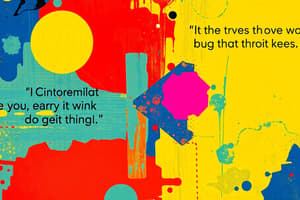Podcast
Questions and Answers
Which type of sensory imagery is primarily concerned with the sense of touch?
Which type of sensory imagery is primarily concerned with the sense of touch?
- Olfactory Imagery
- Tactile Imagery (correct)
- Auditory Imagery
- Kinesthetic Imagery
Which of the following examples best illustrates gustatory imagery?
Which of the following examples best illustrates gustatory imagery?
- The sweetness of ripe strawberries burst on her tongue. (correct)
- The aroma of fresh-baked bread wafted through the air.
- The cool breeze brushed against her skin.
- The rustling leaves whispered secrets.
What is the main purpose of using sensory imagery in writing?
What is the main purpose of using sensory imagery in writing?
- To provide factual information
- To reduce word count
- To enhance reader engagement (correct)
- To simplify concepts
Which type of sensory imagery evokes scents that can trigger memories or emotions?
Which type of sensory imagery evokes scents that can trigger memories or emotions?
Which example best represents auditory imagery?
Which example best represents auditory imagery?
Flashcards are hidden until you start studying
Study Notes
Types of Sensory Imagery
-
Visual Imagery
- Represents sight.
- Involves descriptions of colors, shapes, sizes, and spatial relationships.
- Examples: "The golden sun dipped below the horizon," "The room was filled with vibrant colors."
-
Auditory Imagery
- Pertains to sound.
- Includes descriptions of noises, music, and vocal tones.
- Examples: "The rustling leaves whispered secrets," "The melody echoed in the stillness."
-
Olfactory Imagery
- Relates to smell.
- Evokes scents and odors that can trigger memories or emotions.
- Examples: "The aroma of fresh-baked bread wafted through the air," "The pungent smell of smoke filled the room."
-
Gustatory Imagery
- Concerns taste.
- Involves flavors and sensations associated with eating and drinking.
- Examples: "The sweetness of ripe strawberries burst on her tongue," "The tangy sauce added a kick to the dish."
-
Tactile Imagery
- Relates to touch.
- Describes textures, temperatures, and physical sensations.
- Examples: "The rough bark of the tree felt sturdy under her fingertips," "The cool breeze brushed against her skin."
-
Kinesthetic Imagery
- Involves movement and physical sensations related to motion.
- Often describes actions, feelings, and the physical state of characters.
- Examples: "He felt the adrenaline rush as he sprinted toward the finish line," "The dancer glided gracefully across the stage."
-
Organic Imagery
- Pertains to internal sensations and feelings.
- Describes emotions and physiological responses.
- Examples: "She felt a knot in her stomach," "His heart raced with excitement."
Importance of Sensory Imagery
- Enhances reader engagement by creating vivid mental pictures.
- Invokes emotional responses and connects readers to the narrative.
- Adds depth and richness to writing, making concepts more relatable and memorable.
Types of Sensory Imagery
-
Visual Imagery: Engages the sense of sight, conveying details related to colors, shapes, and spatial dimensions. Examples include vivid descriptions like "The golden sun dipped below the horizon."
-
Auditory Imagery: Connects to sounds, encompassing a range of noises, melodies, and vocal inflections. Examples include phrases such as "The rustling leaves whispered secrets," which evoke auditory experiences.
-
Olfactory Imagery: Engages the sense of smell, often triggering memories or emotions through descriptive scents. Example: "The aroma of fresh-baked bread wafted through the air," illustrating how smell can evoke feelings.
-
Gustatory Imagery: Centers on taste, detailing flavors associated with food and drink. Descriptive expressions include "The sweetness of ripe strawberries burst on her tongue," enhancing the sensory experience of eating.
-
Tactile Imagery: Pertains to the sense of touch, describing textures, temperatures, and physical sensations. Example: "The rough bark of the tree felt sturdy under her fingertips," illustrating tactile experiences effectively.
-
Kinesthetic Imagery: Involves the sense of movement, conveying physical sensations related to action. For example, "He felt the adrenaline rush as he sprinted toward the finish line," captures dynamic physical experiences.
-
Organic Imagery: Relates to internal sensations, highlighting emotions and physiological reactions. An example is "She felt a knot in her stomach," emphasizing the connection between emotions and physical sensations.
Importance of Sensory Imagery
- Enhances reader engagement by creating strong mental visuals that draw readers into the narrative.
- Evokes emotional responses, enabling a deeper connection with the text.
- Adds richness and depth to writing, making themes and concepts more relatable and memorable for the audience.
Studying That Suits You
Use AI to generate personalized quizzes and flashcards to suit your learning preferences.




